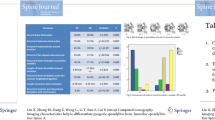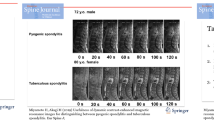Abstract
Magnetic resonance imaging (MRI) is useful for the early diagnosis of pyogenic spondylitis, because it clearly demonstrates edema and inflammatory changes. However, in four of our patients, MRI revealed no clear abnormality and it was difficult to make a diagnosis at the first hospital visit; evidence of pyogenic spondylitis was obtained later. Changes on plain roentgenogram and MRI were investigated at various times over the course of the disease in these patients. Since abnormalities may not be detected by MRI in the early phase of this disease, we recommend that imaging be repeated after at least 2 weeks if no abnormalities are noted at the first hospital visit in patients in whom this disease is suspected because of clinical or laboratory findings.
Similar content being viewed by others
References
Fischer U, Vosshenrich R. Osteomyelitis (“spinal infection”, Spondylitis, Spondylodiszitis) des Dens axis. Rontgenblatter 1990;43:54–7.
Horton WC, Daftari TK. Which disc as visualized by magnetic resonance imaging is actually a source of pain? Spine 1992; 17:S164–71.
Kramer J, Schratter M, Pongracz N, et al. Spondylitis: The clinical picture and follow-up assessment by magnetic resonance tomography. Rofo Fortschr Geb Rontgenstr Neuen Bildgeb Verfahr 1990;59:147–51.
Maruo S, Yamamoto Y, Bessyo B. Diagnosis of inflammatory disease in spine (in Japanese). Seikeigeka Mook (Orthopedic Surgery) 1993;65:203–15.
Maruoka S, Nakamura M. Bone scintigraphy (in Japanese). Seikeigeka Mook (Orthopedic Surgery) 1993;65:106–20.
Partio E, Hatanapaa S, Rokkanen P. Pyogenic spondylitis. Acta Orthop Scand 1978;49:164–8.
Schwend RM, Hennrikus W, Hall JE, et al. Childhood scoliosis: Clinical indications for magnetic resonance imaging. J Bone Joint Surg Am 1995;77:46–53.
Tehranzanden J, Wnag F, Mesgarzarden M. Magnetic resonance imaging of osteomyelitis. Crit Rev Diagn Imaging 1992;33:495–534.
Treves S, Khettry J, Broker FH, et al. Osteomyelitis: Early scintigraphy detection in children. Pediatrics 1976;57:173–86.
Wood KB, Garvey TA, Gundy C, et al. Magnetic resonance imaging of the thoracic spine. J Bone Joint Surg Am 1995;77:1632–8.
Author information
Authors and Affiliations
About this article
Cite this article
Yoshikawa, T., Maeda, M., Ueda, Y. et al. Magnetic resonance imaging in the early phase of pyogenic spondylitis: A report of four cases. J Orthop Sci 2, 16–23 (1997). https://doi.org/10.1007/BF01239754
Received:
Accepted:
Issue Date:
DOI: https://doi.org/10.1007/BF01239754




